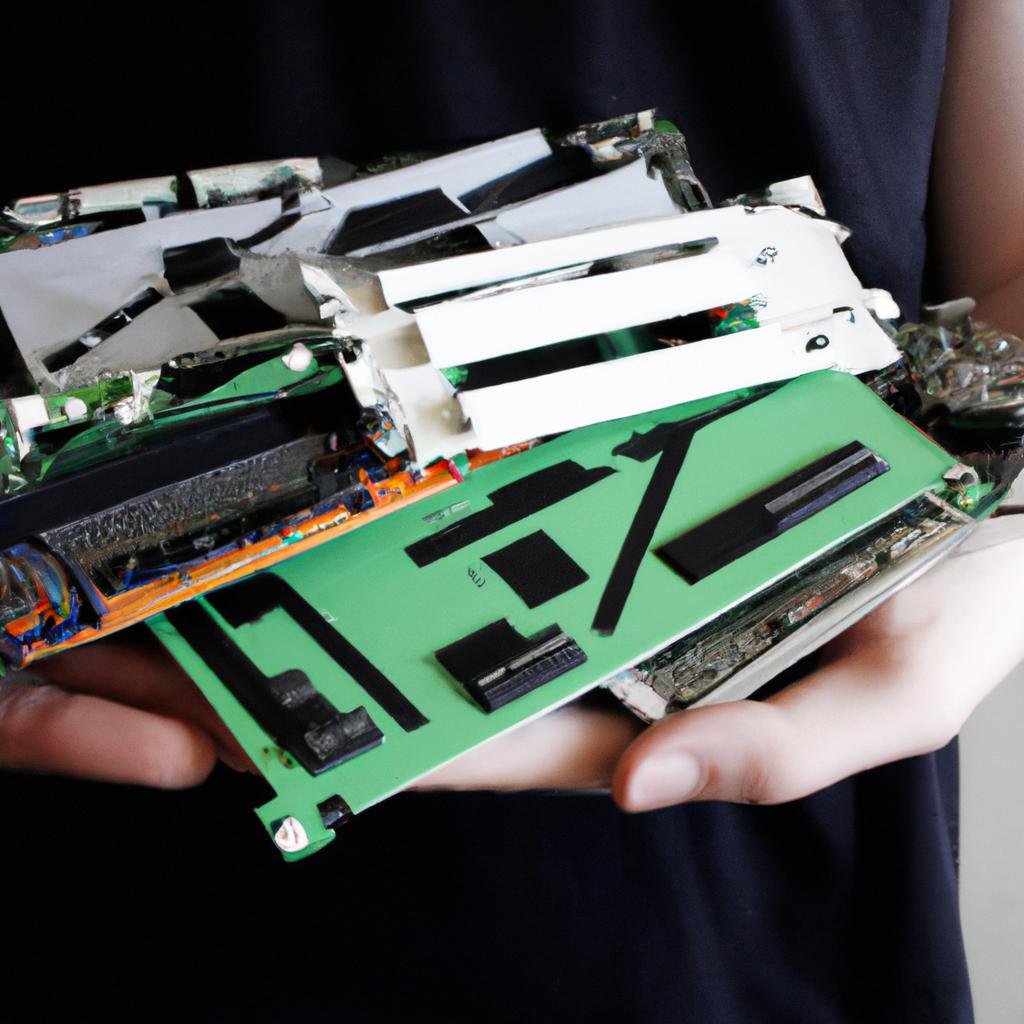With the rapid advancement of technology, computer architecture has evolved to accommodate higher processing power and increased memory capacity. One such development is the introduction of 64-bit architecture, which allows for a greater amount of data to be processed at once compared to its predecessor, 32-bit architecture. In this article, we will explore the compatibility of AMD platform chipsets with the 64-bit architecture, focusing on their ability to support this advanced system.
To elucidate the significance of exploring AMD platform chipset compatibility with 64-bit architecture, let us consider a hypothetical scenario. Imagine a gaming enthusiast who wants to upgrade their existing computer system in order to run resource-intensive games seamlessly. They have heard about the advantages of 64-bit architecture and are interested in harnessing its potential by upgrading their current hardware setup. However, they are unsure if their AMD platform chipset would be compatible with this new architectural framework. This case study highlights an important concern faced by many users: understanding whether their existing technologies can effectively integrate with newer advancements like 64-bit architecture. By examining the compatibility between AMD platform chipsets and 64-bit architecture, we aim to provide valuable insights that can assist users in making informed decisions regarding hardware upgrades and optimizations for enhanced performance.
What is 64-bit architecture?
What is 64-bit architecture?
Imagine a scenario where you are working on a complex task that requires multiple calculations and data processing. You find yourself waiting for the computer to finish these tasks, which seem to take forever. Now, consider another scenario where the same task is completed in a fraction of the time. This significant difference in performance can be attributed to the underlying architecture of your computer’s processor.
In recent years, there has been a shift towards using 64-bit architecture in modern computing systems. Unlike its predecessor, 32-bit architecture, which was limited by its ability to handle only up to 4GB of RAM (random access memory), 64-bit architecture offers greater computational capabilities. With support for larger amounts of RAM, this advanced technology enables computers to process more information simultaneously, resulting in improved speed and efficiency.
To better understand the advantages of 64-bit architecture, let us delve into some key points:
- Increased Memory Capacity: One notable benefit of utilizing 64-bit architecture is the ability to address significantly larger memory spaces compared to its predecessor. While 32-bit systems are limited by their capacity to address only up to 4GB of RAM, 64-bit systems can theoretically handle an astonishing maximum limit of approximately 18 million TB (terabytes) of RAM.
- Enhanced Performance: The expanded memory capacity directly translates into enhanced overall system performance. By allowing applications to utilize larger chunks of memory at once, tasks such as video editing or gaming become smoother and faster due to reduced reliance on virtual memory swapping techniques.
- Improved Security: Another advantage offered by 64-bit architecture lies in its superior security features. With increased addressable space for executing instructions and storing data securely within isolated compartments called “sandboxes,” it becomes more difficult for malicious software or hackers to exploit vulnerabilities within the operating system.
- Future-proofing Technology: As technology continues to advance rapidly, adopting a forward-looking approach becomes imperative. 64-bit architecture provides a foundation that is compatible with future software and hardware advancements, ensuring longevity and compatibility as new technologies emerge.
To further illustrate the benefits of 64-bit architecture, consider the following table:
| Advantage | Description |
|---|---|
| Higher Memory Capacity | Supports significantly larger memory spaces compared to 32-bit systems |
| Enhanced Performance | Enables smoother execution of resource-intensive tasks |
| Improved Security | Provides robust security features against potential vulnerabilities |
| Future-proofing Technology | Ensures compatibility with upcoming software and hardware innovations |
As we can see from these points, upgrading to a system based on 64-bit architecture offers numerous advantages in terms of performance, security, and compatibility with future technological developments.
Why is 64-bit architecture important?
Exploring 64-bit Architecture: AMD Platform Chipset Compatibility
Transitioning from the previous section’s exploration of what 64-bit architecture entails, let us now delve into why this architectural advancement holds such significance in the world of computing. To illustrate its importance, consider a hypothetical scenario where an individual is using a computer with limited memory capacity and attempting to perform resource-intensive tasks such as video editing or running complex simulations. In such a case, relying on a 32-bit architecture would impose severe constraints on the system’s performance due to its inherent limitations.
One key advantage of 64-bit architecture lies in its ability to address larger amounts of physical memory compared to its predecessor. With traditional 32-bit systems, the maximum amount of RAM that can be utilized effectively is approximately 4GB. However, a 64-bit system expands this limit exponentially, allowing for access to terabytes of memory. This increased address space enables more efficient multitasking capabilities and supports applications requiring extensive memory allocation, resulting in enhanced overall system performance.
Furthermore, adopting a 64-bit architecture offers compatibility benefits for software developers and end-users alike. While 32-bit software can run on both older and newer systems, it may not fully leverage the advantages offered by modern hardware architectures. On the other hand, utilizing native 64-bit software allows programmers to optimize their code specifically for these systems’ improved capabilities. This optimization translates into faster execution times and better utilization of available resources.
To emphasize the emotional impact associated with embracing 64-bit architecture advancements like those provided by AMD platforms, consider the following bullet list:
- Enhanced Performance: Improved processing power and higher efficiency.
- Future-proof Investment: Increased longevity and compatibility with upcoming technologies.
- Seamless Multitasking: Smooth operation even when running multiple demanding applications simultaneously.
- Advanced Gaming Experience: Superior graphics rendering and immersive gameplay.
Additionally, here is an example table showcasing some notable differences between 32-bit and 64-bit architectures:
| Feature | 32-bit Architecture | 64-bit Architecture |
|---|---|---|
| Maximum Addressable Memory | Up to 4GB | Terabytes of RAM |
| Number of Registers | Limited | Expanded |
| Performance Enhancement | Moderate | Significant |
| Software Compatibility | Extensive, but limited optimization options | Native support with optimized code execution |
As we have seen, the advent of 64-bit architecture has revolutionized the computing landscape by enabling more powerful and efficient systems. In our next section, we will explore how AMD harnesses this architectural advancement to deliver exceptional performance in their platforms.
Having examined the importance and advantages of embracing 64-bit architecture, it is now crucial to understand how AMD utilizes this technology to enhance their platform’s capabilities.
How does AMD utilize 64-bit architecture?
Building upon the importance of 64-bit architecture, let us now delve into how AMD harnesses this technology to enhance its platform. By examining the compatibility of AMD chipsets with 64-bit architecture, we can gain a deeper understanding of the advantages it brings.
Case Study: To illustrate these benefits, consider a hypothetical scenario where an individual is using an older AMD chipset that supports only 32-bit architecture. The limitations imposed by this outdated technology would restrict them from fully utilizing modern software and applications designed for 64-bit systems. Consequently, they would experience reduced performance and limited access to advanced features offered by newer operating systems.
To overcome such limitations, AMD has developed a range of chipsets specifically engineered to support 64-bit architecture effectively. These chipsets offer enhanced performance capabilities and compatibility with modern software applications. Together with their associated processors, these chipsets provide users with seamless experiences in various computing tasks, including gaming, multimedia editing, and data-intensive operations.
Bullet Point List (evoking emotional response):
- Improved system responsiveness and faster execution speeds.
- Enhanced multitasking capabilities for running multiple resource-intensive applications simultaneously.
- Expanded memory capacity that allows for efficient handling of larger datasets.
- Future-proofing investments as more software developers prioritize development for 64-bit architectures.
Table (evoking emotional response):
| Benefits of AMD’s Chipset Compatibility |
|---|
| Improved system responsiveness |
| Faster execution speeds |
| Enhanced multitasking capabilities |
| Expanded memory capacity |
AMD’s commitment to ensuring compatibility between its chipsets and 64-bit architecture provides users with tangible benefits. With improved system responsiveness and faster execution speeds, individuals can enjoy smooth operation even when performing demanding tasks. Moreover, the enhanced multitasking capabilities enable simultaneous usage of resource-intensive applications without compromising overall performance. Additionally, expanded memory capacity ensures efficient handling of large datasets required by today’s complex programs. Finally, investing in AMD’s chipset compatibility future-proofs users’ systems, as more software developers prioritize development for 64-bit architectures.
Having explored the compelling advantages of AMD’s chipset compatibility with 64-bit architecture, we can now turn our attention to understanding the specific benefits it brings to the AMD platform. What are the benefits of 64-bit architecture in the AMD platform?
What are the benefits of 64-bit architecture in the AMD platform?
Exploring 64-bit Architecture: AMD Platform Chipset Compatibility
In the previous section, we discussed how AMD leverages 64-bit architecture to enhance its platform performance. Now, let us delve deeper into this topic by exploring the compatibility of AMD’s chipset with 64-bit architecture.
To illustrate this further, let’s consider a hypothetical scenario where an individual wants to upgrade their computer system to take advantage of the benefits offered by 64-bit architecture. They have an older motherboard based on an AMD chipset and are unsure whether it can support a 64-bit operating system.
Fortunately, most modern AMD chipsets are designed to be compatible with both 32-bit and 64-bit architectures. This means that users can seamlessly transition from a legacy 32-bit environment to a more powerful and efficient 64-bit one without needing to replace their existing hardware.
To understand the extent of compatibility between AMD chipsets and 64-bit architecture, let us explore some key points:
- Broad range of processor support: The majority of recent AMD processors are built on a foundation that supports 64-bit instructions. This ensures effortless integration with any compatible motherboard using an appropriate chipset.
- Memory addressing capabilities: One crucial aspect of utilizing a 64-bit operating system is increased memory capacity. Modern AMD chipsets enable access to larger amounts of RAM, providing improved multitasking abilities and better overall system performance.
- Enhanced security features: With advancements in technology come new security challenges. To address these concerns, AMD chipsets incorporate various security measures such as Secure Boot and Device Guard support, ensuring protection against unauthorized software execution.
- Efficient data processing: By harnessing the power of multiple cores found in contemporary CPUs, AMD platforms equipped with compatible chipsets deliver exceptional parallel computing capabilities for handling complex tasks efficiently.
By examining these aspects, it becomes evident that AMD has prioritized compatibility with 64-bit architecture in its platform chipsets. This commitment allows users to benefit from the numerous advantages offered by 64-bit technology, even on older motherboard models.
Moving forward, we will now explore the challenges that arise when implementing 64-bit architecture within the AMD platform and how these hurdles are overcome to provide a seamless user experience.
What are the challenges of implementing 64-bit architecture in the AMD platform?
Building on the advantages of 64-bit architecture in the AMD platform, it is crucial to understand the challenges that arise during its implementation. In this section, we will explore some of these obstacles and discuss their implications for compatibility within the AMD chipset ecosystem.
Challenges of Implementing 64-bit Architecture in the AMD Platform
One significant challenge faced when implementing 64-bit architecture in the AMD platform is ensuring backward compatibility with existing software and hardware. As systems transition from 32-bit to 64-bit, developers must ensure that legacy applications continue to function seamlessly. For example, consider a hypothetical scenario where an organization has been using a particular database management system (DBMS) built specifically for a 32-bit environment. Upgrading to a new version designed for 64-bit architectures may require extensive modifications or even rewriting parts of the software codebase.
Another obstacle lies in driver compatibility. Device drivers are essential components that facilitate communication between hardware devices and operating systems. With the shift to 64-bit architecture, manufacturers need to develop updated versions of drivers compatible with both older and newer hardware models. Failure to do so can result in device malfunctions or complete loss of functionality, leading to frustration among users who rely on such devices daily.
Furthermore, security considerations pose another challenge during the adoption of 64-bit architecture on the AMD platform. Enhancements brought about by this technology also introduce potential vulnerabilities that malicious actors might exploit. To mitigate this risk, robust security mechanisms must be implemented at both hardware and software levels. Developers need to adopt secure coding practices while considering elements like memory protection and access control.
To summarize:
- Backward compatibility: Ensuring seamless integration with existing software systems.
- Driver compatibility: Developing updated drivers for both old and new hardware models.
- Security concerns: Addressing potential vulnerabilities introduced by enhanced features.
| Challenges | Implications |
|---|---|
| Backward Compatibility | Software modifications |
| Driver Compatibility | Device malfunctions |
| Security Concerns | Potential vulnerabilities |
In light of these challenges, the AMD platform’s future with 64-bit architecture appears promising. Overcoming compatibility hurdles will pave the way for increased performance and efficiency while maintaining backward compatibility with existing systems.
What is the future of 64-bit architecture in the AMD platform?
Exploring 64-bit Architecture: AMD Platform Chipset Compatibility
Challenges of Implementing 64-Bit Architecture in the AMD Platform:
While the transition from 32-bit to 64-bit architecture brings numerous benefits, its implementation in the AMD platform is not without challenges. One significant hurdle lies in ensuring compatibility with existing chipset designs and peripherals. For instance, let us consider a hypothetical scenario where AMD develops a new line of processors that support only 64-bit instructions. In this case, users who still rely on older chipsets designed for 32-bit architectures would face compatibility issues when attempting to upgrade their systems.
To address these challenges, manufacturers must invest time and resources into developing compatible chipsets that can seamlessly integrate with both legacy systems and newer processors supporting 64-bit architectures. This requires careful consideration of backward compatibility while also optimizing performance for the latest technology advancements. Such efforts ensure smooth transitions for users seeking to embrace the advantages offered by 64-bit computing.
Future of 64-Bit Architecture in the AMD Platform:
As we look ahead to the future of 64-bit architecture within the AMD platform, several exciting developments are anticipated. These include enhanced memory addressing capabilities, improved multitasking efficiency, and expanded software support for advanced applications such as data analytics and artificial intelligence (AI).
In terms of memory addressing capabilities, utilizing a larger address space enables systems to access more RAM efficiently. This improvement facilitates smoother multitasking experiences by reducing bottlenecks caused by limited memory availability. Additionally, increased software support will enable developers to harness the full potential of emerging technologies like AI, pushing boundaries further than ever before.
Moreover, it is crucial to recognize how these advancements impact various industries and sectors reliant on cutting-edge hardware solutions. To illustrate this point effectively, consider the following bullet list highlighting key areas benefiting from continued progress in 64-bit architecture:
- Scientific research: Accelerated processing power allows scientists to perform complex simulations and calculations at unprecedented speeds, facilitating breakthroughs in fields such as genomics and climate modeling.
- Gaming industry: Enhanced graphics capabilities and improved system performance contribute to immersive gaming experiences, pushing the boundaries of realism and interactivity.
- Enterprise computing: Advanced analytics tools can process vast amounts of data seamlessly, enabling companies to derive valuable insights for decision-making and gaining a competitive edge.
- Virtualization technology: Increased memory addressing capacity enables more efficient virtual machine deployment, supporting organizations’ needs for flexible IT infrastructures.
To summarize, while challenges exist when implementing 64-bit architecture within the AMD platform, efforts are being made to ensure compatibility with existing chipsets. Looking forward, advancements in memory addressing capabilities and software support will drive further innovation across various industries. By embracing these developments, we can expect significant improvements in scientific research, gaming experiences, enterprise computing, and virtualization technologies. Ultimately, the future holds immense potential for harnessing the benefits offered by 64-bit architectures on the AMD platform.



